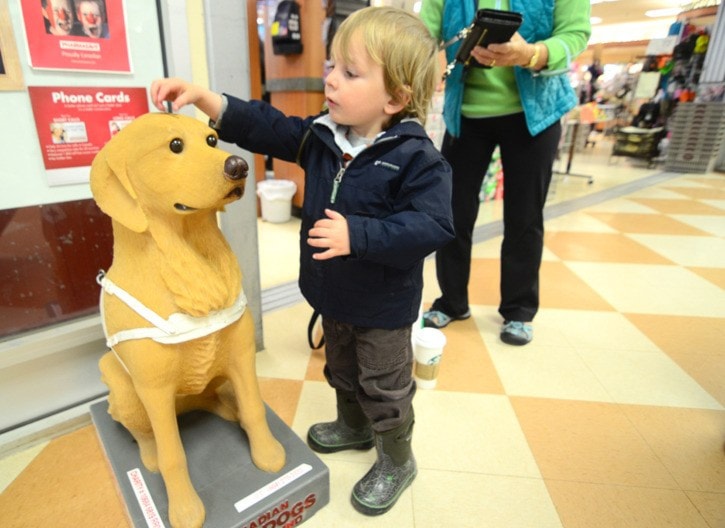Steven Doucette, special events manager for The Canadian Guide Dogs for the Blind, wants Smithers residents to know they consider themselves a local service.
The national charity provides assistance to visually-impaired Canadians by providing and training them in the use of professionally trained Guide Dogs.
“We visit applicants in any community they are in,” said Doucette.
“If somebody in your area applied for a guide dog, we would send one of our instructors and they would do an assessment and an interview.”
While most people recognize the life-size donation dog near Pharmasave as something that supports the visually impaired, some confusion exists.
“Sometimes people think it’s for the food bank,” said Beannie Collingwood, 63.
Pharmasave staff put the dog on display at their entrance daily, and Collingwood has been emptying it of its donations monthly since 2000, depositing donations into an account for the Canadian Guide Dogs for the Blind.
“Another challenge the organization faces,” said Doucette, “Is that a lot of people, when they think of visually impaired people, tend to think of the Canadian National Institute for the Blind.
“While the CNIB provides great services, they don’t train guide dogs. People that love dogs often donate to the SPCA or Humane Society, so we’re kind of caught in the middle sometimes.”
Once accepted, the applicant is placed on a short-term waiting list. But the next applicant on the list does not necessarily get the next dog.
“One of the special things we do, is we actually look at about a dozen criteria and match a specific dog with a specific person,” said Doucette.
Wait times vary from one month up to two years, depending on what dogs are available.
The goal, is to find the perfect match between applicant and dog and many factors are taken into account: from the size of the person to the personality and temperament of the dog and applicant.
“We don’t want to send out a guide dog team back to their home and not have it work out,” said Doucette.
Returning clients can move up the queue slightly faster.
Once accustomed to having a dog, being without one can be difficult. “Some clients have compared it to somebody who drives their entire life and suddenly taking their car away,” said Doucette.
Another challenge is that many people still go to dog training schools in the United States.
Sometimes it can be quicker to get a guide dog in the United States but doing so can have drawbacks.
Canadian Guide Dogs for the Blind retain ownership of the dog for its working life.
If there is ever an issue they can take the dog back, something not easily done when or even offered with some training schools to the south.
“That is one of the bonuses of staying in Canada and coming to our organization,” Doucette said.
“People should consider us local.”
For example, Doucette said if somebody in Smithers or in the Bulkley Valley, needs a guide dog, there is no place in the community dealing with service dogs.
However, while the CGDB office is located in Ottawa, they do provide services in local communities across the country.
“If there is a legally blind person who requires a guide dog,” Doucette said, “They can contact us anytime to start the process and we will make it happen.”
For more information about the program or to make an online donation, visit the Canadian Guide Dogs for the Blind website at www.guidedogs.ca, email at info@guidedogs.ca or telephone at 613-692-7777.
